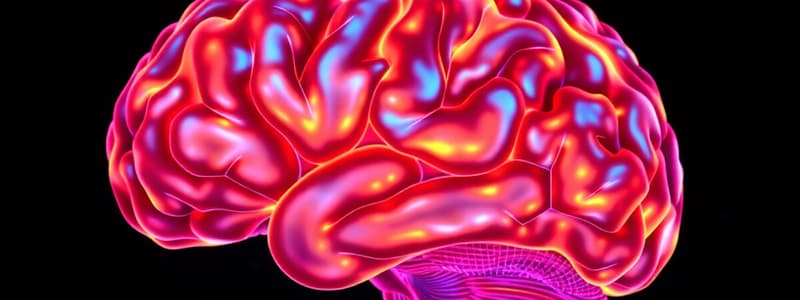Podcast
Questions and Answers
What is the function of the "Angular gyrus and supramarginal gyrus" according to the text?
What is the function of the "Angular gyrus and supramarginal gyrus" according to the text?
- Language comprehension
- Language production and grammatical processing
- Reading and writing (correct)
- Processing auditory information
Based on the provided content, what is the primary method used to measure blood flow changes to identify active brain regions?
Based on the provided content, what is the primary method used to measure blood flow changes to identify active brain regions?
- Electroencephalography (EEG)
- Functional Magnetic Resonance Imaging (fMRI) (correct)
- Autopsy
- Magnetoencephalography (MEG)
What is the primary function of Broca's Area?
What is the primary function of Broca's Area?
- Language production and grammatical processing (correct)
- Language comprehension
- Auditory processing
- Visual processing
What did the autopsy of LeBorgne, "tan", reveal about the brain region associated with his speech impairment?
What did the autopsy of LeBorgne, "tan", reveal about the brain region associated with his speech impairment?
What type of research method is used to capture electrical brain activity using scalp electrodes?
What type of research method is used to capture electrical brain activity using scalp electrodes?
Which of the following is NOT a biological discipline that is highly relevant to the neurobiology of language, based on the text?
Which of the following is NOT a biological discipline that is highly relevant to the neurobiology of language, based on the text?
What is the ultimate goal of understanding the neurobiology of language?
What is the ultimate goal of understanding the neurobiology of language?
Which of the following statements accurately reflects the definition of neurobiology of language provided in the text?
Which of the following statements accurately reflects the definition of neurobiology of language provided in the text?
What is the main purpose of the passage, as presented in the text?
What is the main purpose of the passage, as presented in the text?
Which of the following is NOT a core aspect of neurobiology of language, as described in the text?
Which of the following is NOT a core aspect of neurobiology of language, as described in the text?
Flashcards
Neurobiology of Language
Neurobiology of Language
The study of biological mechanisms involved in speech and language production and understanding.
Brain Imaging Studies
Brain Imaging Studies
Techniques used to visualize brain activity related to language processing.
Types of Brain Imaging Methods
Types of Brain Imaging Methods
Different techniques, like fMRI and PET scans, to study brain function.
Cognitive Processes
Cognitive Processes
Signup and view all the flashcards
Physiological Approach to Therapy
Physiological Approach to Therapy
Signup and view all the flashcards
Broca's Area
Broca's Area
Signup and view all the flashcards
Wernicke's Area
Wernicke's Area
Signup and view all the flashcards
Angular Gyrus
Angular Gyrus
Signup and view all the flashcards
Functional MRI (fMRI)
Functional MRI (fMRI)
Signup and view all the flashcards
Electroencephalography (EEG)
Electroencephalography (EEG)
Signup and view all the flashcards
Study Notes
Neurobiology of Language Overview
- Neurobiology of language is a rapidly evolving field, with ongoing research continuously improving understanding of brain processes related to language
- Current research suggests language processing relies on dynamic and structural interactions within the brain's functional architecture.
- The brain exhibits neuroplasticity, i.e., the ability to reorganize and form new neural connections, which influences language processing.
Key Brain Areas
- Broca's Area: Located in the frontal lobe, crucial for language production and grammatical processing.
- Wernicke's Area: Found in the temporal lobe, responsible for language comprehension.
- Additional Regions: The angular gyrus and supramarginal gyrus are involved in reading and writing.
Research Methods
- fMRI (Functional Magnetic Resonance Imaging): Measures blood flow changes to identify active brain regions during language tasks.
- EEG (Electroencephalography): Captures electrical brain activity via scalp electrodes.
- MEG (Magnetoencephalography): Measures magnetic fields generated by brain activity to analyze neural activity related to word prediction and lexical pre-activation.
Recent Research
- Schell et al. (2017): Study on differential cortical contributions of syntax and semantics in processing two-word phrases, which highlights sentence processing and syntactic complexity. Specific regions (inferior frontal gyrus), activated based on the type of language processing. This study demonstrated that the brain engages in language functions through complex interactions within the brain network.
- Dikker & Pylkkänen (2013): Investigated lexical pre-activation in language processing, looking at how the brain anticipates upcoming words using MEG. Findings demonstrate early responses linked to the activation of expected words, within specific regions of the brain, including the left mid-temporal cortex and the ventro-medial prefrontal cortex.
- Aliko et al. (2023): Study challenges the concept of localized "language regions", suggesting that the entire brain is involved in language tasks, rather than isolated areas. Their findings support the notion of a distributed network architecture within the brain for language processing.
Key Findings of Neurobiology of Language
- Neuroplasticity: The brain's ability to reorganize and form new neural connections is crucial for language processing.
- Distributed network model: Studies emphasize a distributed network model where syntax and semantics are processed through separate, but interconnected pathways within the brain.
- Overlearning: Overlearning a sentence produces reorganization of brain activity, influencing sensorimotor regions in the brain, and possibly providing an explanation for preserved residual abilities with formulaic expressions in individuals with aphasia or Alzheimer's.
Implications of Findings
- Language processing is influenced by the brain's functional architecture, involving dynamic interactions.
- Insights from research have implications for education, therapy, and artificial intelligence.
Language Network
- The language network involves multiple interconnected brain regions.
- Coordinated activity within these regions is critical for language use.
Studying That Suits You
Use AI to generate personalized quizzes and flashcards to suit your learning preferences.




